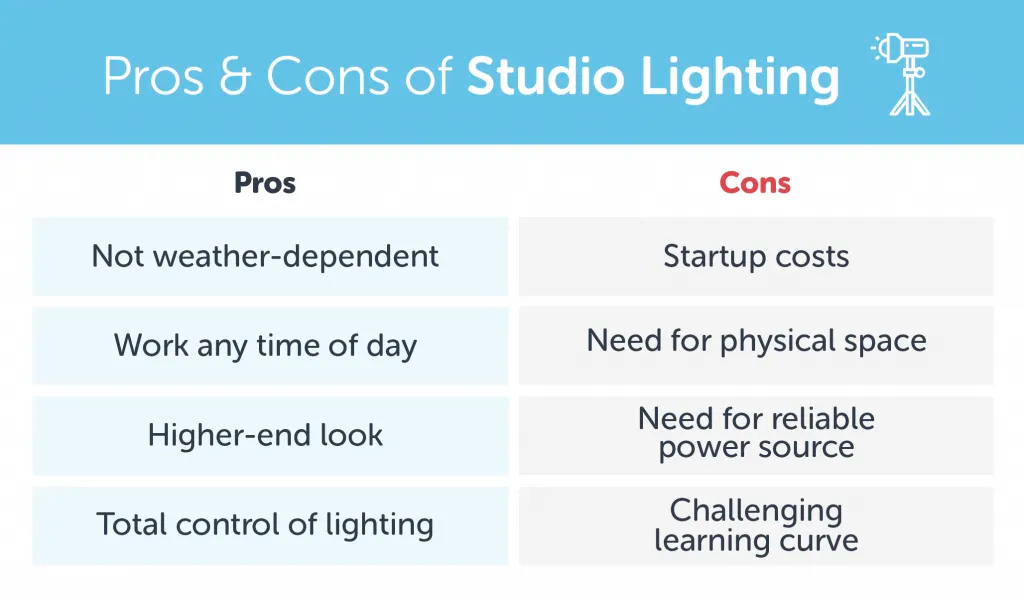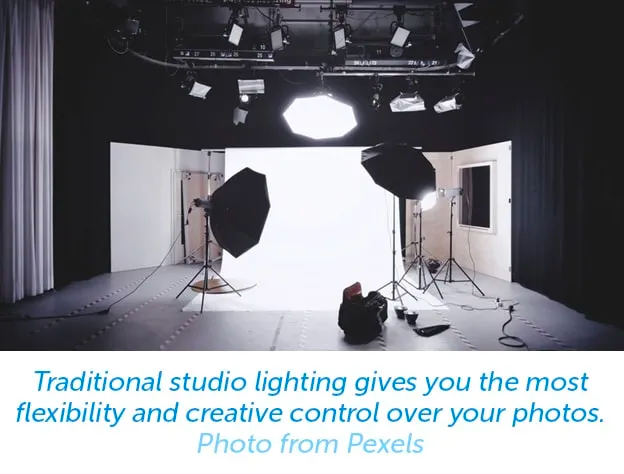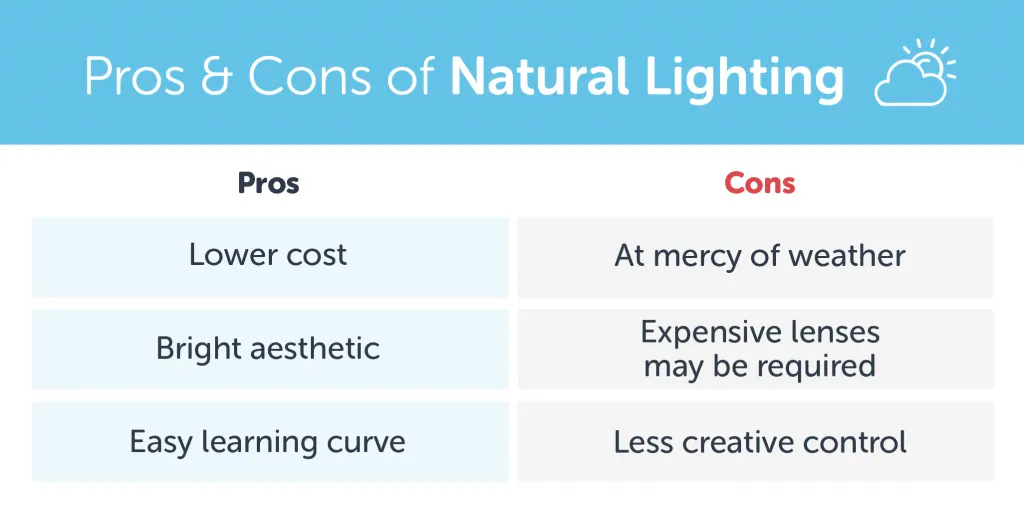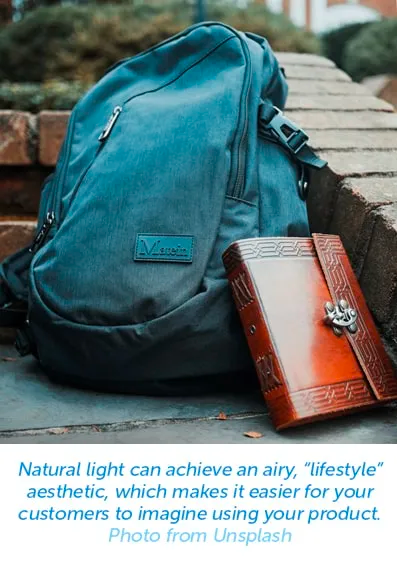Here’s a fun fact for you: customers trust images even more than product reviews when it comes to buying online.
That means that for an ecommerce company, great product photography is an excellent opportunity to increase customer confidence and drive sales.
However, truly effective product photography is more than just pointing and clicking a camera. The best images help you maintain a professional, seamless appearance across all pages of your website.
So how do you accomplish that?
One way is to create a consistent look through your lighting choice.
There are two main types of product photography lighting you can choose from: traditional studio lighting and natural light.
Some products are better suited to the bold or creative effects achieved through studio lighting while others may benefit from a more natural “lifestyle” aesthetic.
In this post, we’ll cover both types of lighting and the pros and cons of each.
The Pros of Studio Lighting for Product Photography
Let’s kick off by looking at the pros of studio lighting for product photography.

You Don’t Have To Work Around the Weather
Studio lighting is fixed and reliable. Indoor studios eliminate the requirement of good weather which is critical if you live in an area where there’s frequent rain or snow. When you’re working with a professional lighting setup, you never have to worry about a passing cloud ruining a set of images.
You Can Photograph Any Time of Day
With studio lighting, you can do product photography at the time of day that works for your schedule — even if it’s late at night. If you’re busy running your ecommerce business during the day, studio lighting will likely provide the greatest flexibility for photoshoots.
You Add Credibility and Make Your Photos Look More High-End
Professional-looking photos shot in studio lighting help build ethos for your brand by making you appear more professional and polished. This also makes your products look more high-end, and helps you justify a higher price point.
You Can Control Exactly How Your Photos Look
Studio lighting offers total creative control. You get to decide how intense the light is, the direction it’s coming from, and the shape of the light. In addition, you can use light diffusers to alter the harshness or color of the light.
For example, you could use umbrella diffusers to soften the light (creating a warm or romantic aesthetic), or you could use colored diffusers for a more dramatic look. This creative flexibility can make it easier to get images that reflect your brand.

The Cons of Studio Lighting for Product Photography
Now let’s look at some of the cons that come with studio lighting.
Studio Lights Can Be Expensive
You’ll likely need to purchase more than one studio light, and you may need to invest in an entire studio lighting kit. While the investment pays off in the long run, the upfront cost can be hard to swallow if you’re cash-strapped. Studio lighting kits for beginners can cost up to $350, while more professional studio lighting kits can cost thousands.
You Need a Physical Studio Space
Whether it’s permanent or temporary, you’ll need a studio space in which to shoot your product photos with a studio lighting setup (which is another expense you’ll need to consider). Even a short-term space rental could add up quickly, so unless you have a spot you can use for free (or close to it), you may need to consider another option.
You Need a Reliable Power Source
Studio lights require a power source. This may not be a problem if you plan to shoot all your images in a studio, but it does mean that you will be limited to spaces with plenty of outlets.
If you want to shoot outdoors or on location, you may have to buy a battery pack or a generator. Not only is this an additional cost, but it also adds more equipment to haul back and forth to the shoot location.
There’s a Learning Curve
You probably weren’t born with an innate sense of how to set up studio lights, so you’ll need to spend some time learning the basics of soft versus hard light, color saturation, and the positioning of your lights around your products. This may take even longer to learn if you want to become enough of an expert in lighting to develop a unique look for your brand.
The Pros of Natural Light for Product Photography
So, what about natural light photography? Let’s dive into the pros of this approach next.

It’s Cheaper
All you need to take photos of your products in natural light is your camera. Though you may have to invest in a quality camera if you don’t already own one, you won’t have to purchase additional equipment. That makes natural light the more cost-effective choice.
Your Photos Will Have a Bright and Airy Aesthetic
This sought-after look is difficult to achieve with studio lighting. Customers are most likely to purchase something when they can easily imagine using or wearing it. Laid-back, lifestyle-type images taken in natural light can be an easy way to help customers envision your product in their lives, thus potentially boosting sales.
There’s No Learning Required
Even if you’re not trained as a photographer, you’re likely able to capture decent photos of your products in natural light. For the time-crunched ecommerce company, being able to immediately step into the role of the photographer is important.
You won’t have to spend hours researching how to use studio lighting effectively, and you don’t have anything to set up. Just grab your camera and your product and head outside.

The Cons of Natural Light for Product Photography
As with anything, there are cons for natural light photography as well.
You’re at the Mercy of the Weather
Rain and snow make photographing outdoors challenging. You’ll have to plan shoots with the weather in mind, which makes natural light the less flexible option.
Additionally, you have to pay close attention to the sun’s position when you want to photograph your products. The light will look much different depending on the time of day.
For example, during the middle of the day, the sun is directly overhead which means the light will be very bright and possibly too harsh. During mornings and evenings, the light is softer and more flattering but because the sun is at an angle, you’ll have to carefully position products to avoid unpleasant shadows.
More Expensive Lenses May Be Required
The variability of natural light and outdoor environments means that a standard lens on your camera may not be good enough for quality photos.
Ultimately, you may need to purchase a faster lens to avoid blurry photos when the natural light is too low. A faster lens also ensures that any objects moving in the background, like birds or falling leaves, don’t blur.
You Don’t Have As Much Creative Control
While the natural light aesthetic can be beautiful, it’s not exactly unique. You can photograph from different angles or even incorporate some creative staging, but you’ll never be able to produce the truly dramatic or imaginative looks possible with studio lighting.
Choosing the Right Lighting for Product Photography: Your Call
The best lighting for product photography depends on your brand, your budget, and your time constraints. Before you decide whether to use traditional studio lighting or natural light, it’s helpful to consider what’s most important for your ecommerce company.
Remember that your choice of lighting will impact how your products are perceived by your customers. Online stores don’t have the option for customers to touch, try on, or test out your products before they buy, so your product photography needs to showcase your products in their best light.
Need an Ecommerce Hosting Solution?
Managed WooCommerce Hosting from Nexcess comes standard with image compression which will keep your images looking excellent while retaining site speed, along with premium plugins which will enable more functionality for your product pages to shine.
Check out our fully managed WooCommerce hosting plans to get started today.

